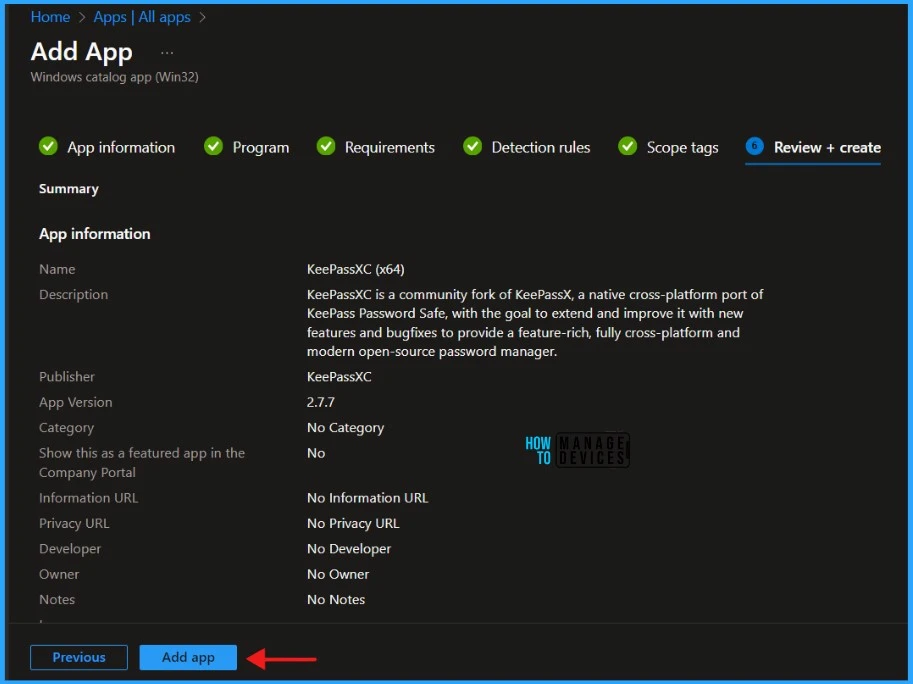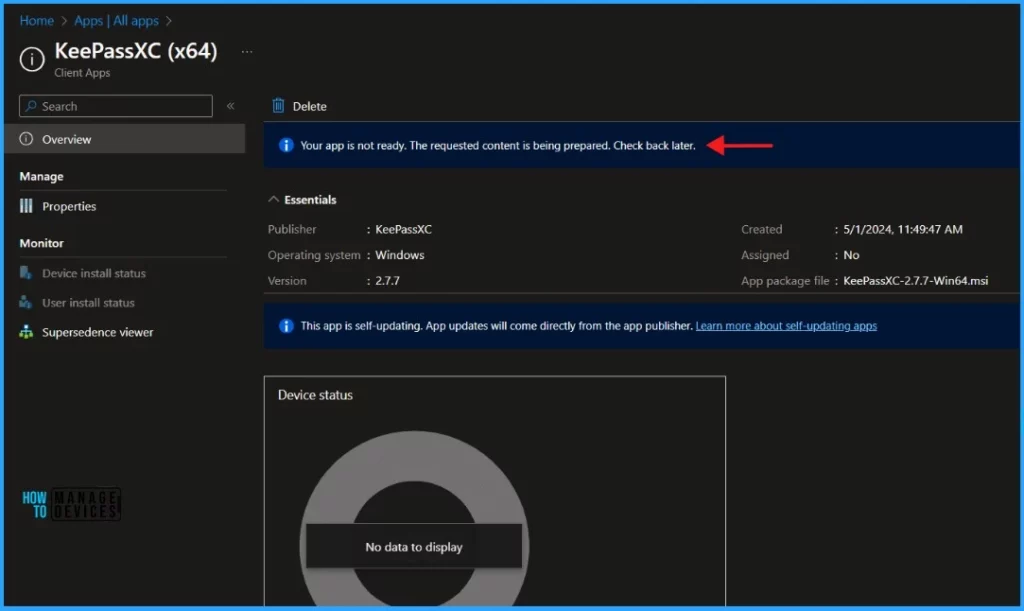The following discourse aims to provide insight into the process of Install KeePassXC app using the Enterprise Application Catalog applications through Intune. This discussion will serve as a good guide for individuals seeking to gain a thorough understanding of application deployment in an enterprise setting.
KeePass is a password manager that is both free and open-source. It helps you manage your passwords securely by storing them all in one database, which is protected by a master key. The aforementioned key serves as the sole prerequisite for unlocking the entire database, thereby alleviating the need for multiple passwords. Overall, this feature provides a streamlined and secure password management experience.
The KeePass database files are fully encrypted, meaning that not only your passwords but also your usernames, URLs, notes, and other information are secure. The best encryption algorithms, including AES, ChaCha20, and Twofish, are used to guarantee the safety of database files.
The KeePass Password Safe Manager is designed primarily for the Windows operating system. However, KeePassXC was developed to address other OS other than the Windows. Also, the key difference is that KeePass is written in .NET, and KeePassXC is written in C++.

What are the Benefits of Enterprise App Management
There are numerous benefits to utilizing Enterprise App Management. Let’s learn about those benefits. A big shout out to Microsoft for creating beautiful documents and making our lives easy.
When you add any Enterprise App Catalog application, Intune itself auto-fills many details. For example, The Commands to install and uninstall the app, the Name of the application, the App Version, the number of minutes the system will wait for the installation of the program to finish, the detection rule, etc. Microsoft recommends using the pre-populated fields containing specific commands and rules. But you can modify the pre-populated fields if you want.
You can request to add an application to the Enterprise App Catalog. If you aren’t already working with a Microsoft contact, fill out the form to request to add an application to the Enterprise App Catalog. Also, Microsoft hosts the applications in Microsoft storage.
Note! Microsoft makes no guarantee, express or implied, with respect to adding a requested app to the Enterprise App Catalog. Once the submission is reviewed using the form provided above, the app may or may not be added to the Enterprise App Catalog. Microsoft does not offer or assume any Service Level Agreement (SLA) or timeline with regard to adding an app to the Enterprise App Catalog.- Deploy KeePass Using Intune LOB App Guide
- Deploy KeePass using SCCM | Step-By-Step Guide
- How to Deploy Putty Windows Line-Of-Business app using Intune
Install KeePassXC with Intune Enterprise App Catalog App
We have discussed enough about KeePassXC and the Enterprise App Catalog. Let’s start Installing KeePassXC with Intune Enterprise App Catalog App.
- Sign in to the Microsoft Intune Admin portal.
- Select Apps > All Apps> Add.

On the Select app type pane, select Enterprise App Catalog app Intune application type from the drop-down menu and click Select. After clicking on the Select button, you will see a list of new apps from the Enterprise App Catalog.

NOTE : Enterprise App Catalog apps are offered as part of Enterprise App Management. When Enterprise App Management becomes generally available, your Global or Billing Administrator can add it for an additional cost to the licensing options that include Microsoft Intune.Then, Click on the Search the Enterprise App Catalog link to display the search panel, which features a search bar.

In the search bar, type the name of the application you want to install. In this example, I will search for KeePassXC and Select it. You can search for applications only by their names. Click Next to continue.

Once you click Next, a new page will ask you to Select the Configuration. Click Select to view the application details.
- Name: The app’s name is prepopulated from the store’s metadata. This field can be edited.
- Description: The app’s Description is prepopulated from the store’s metadata.
- Publisher: The app’s Publisher is prepopulated from the store’s metadata.
- App Version: The version of the app
- Category: Optionally, select one or more of the built-in app categories or a category you created.
- Show this as a featured app in the Company Portal: Display the app prominently on the main page of the company portal when users browse for apps.
- Information URL: Enter the URL of a website that contains information about this app. The URL appears in the company portal.
- Privacy URL: Enter the URL of a website that contains privacy information for this app. The URL appears in the company portal.
- Developer: Enter the name of the app developer.
- Owner: Enter the name of the owner of this app.
- Notes: Enter any notes that you want to associate with this app.
- Logo: Upload a logo that’s associated with the app.
I have listed the supported fields along with the metadata of the selected app above. The information related to the application is displayed along with the metadata of the chosen app.
NOTE! Microsoft does not assert compliance or authorizations for non-Microsoft apps. Customers are responsible for ensuring that apps meet their requirements.
It is possible to modify the auto-populated data; however, it is not recommended to do so. It is advisable to proceed by clicking on the Next button to view the Program.

The Install and Uninstall commands are auto-filled; there is no need to make any changes to them. The default value for the number of minutes the system will wait for the install program to finish is 60 minutes. I recommend thoroughly studying the settings and making the necessary changes. Click Next to continue.
Install command : "%SystemRoot%\System32\msiexec.exe" /i "KeePassXC-2.7.7-Win64.msi" /qnUninstall command : "%SystemRoot%\System32\msiexec.exe" /X {2D8B88BF-C678-465A-8C59-92DFF9CB311C} /qn

Specify the requirements that devices must meet before the app is installed. The minimum operating system needed to install the app is Windows 10 1607. Click Next to continue.

When you click on Next, the Detection Rules tab will appear. The Enterprise Application Catalog apps include predefined Detection Rules, which are one of the most important and life-saving features. You can Add or Delete any defined Detection Rules. Click Next to display the Scope tags page. Add the Scope tags if you wish, and click Next to Review and Create the application.

On the Review and Create tab, check the application settings and click on Add app. When you click on Add App, you will still receive this banner. The app is not ready. Microsoft provides you with the application and binary while you wait for the upload.

- Update 3rd Party Apps using Intune Windows Catalog App
- Block Windows Registry Access using Intune Settings Catalog
You must have noticed that the application is not deployed to any groups. Let’s see how we can deploy the newly created application.
After preparing the KeePassXC application, select Properties and edit the assignment. From the application properties, you can deploy it to groups. I will deploy it to the HTMD – Test Computers Group.

- Integrate Power BI with Intune and Create Reports using Power BI
- Automate Microsoft Intune Device Compliance Report using Graph API
Monitor Enterprise Application Catalog in Intune
The latest version of KeePassXC is deployed to Microsoft Entra ID groups. Since it’s deployed in Required mode, the installation should occur on the client device as soon as possible.
The installation status can be monitored from the Intune portal. Let’s see how to monitor the deployment and status of the installation from the Intune portal.
- Select Apps > All Apps and enter the name of the application in the search bar.
The Intune portal displays the recently created application. Select the desired application and click Overview. You can view a detailed report of recent app deployments, including information on whether the app is Installed, Not Installed, Failed, Install Pending or Not Applicable.

- 6 Exciting Features Coming to Intune Enterprise App Management
- Install Mozilla Firefox with Intune Enterprise App Catalog App
- Install GitHub CLI with Intune Enterprise App Catalog App
End-User Experience – KeePassXC Installation from Enterprise Application Catalog
The KeePassXC 2.7.7 will be automatically installed after it is deployed to workstations since it was marked as a required deployment. You may wonder how to monitor the deployment from the client side.
Open the Company Portal on the workstation and navigate to Download & Updates. The KeePassXC 2.7.7 application should appear as installed.

I trust that this article will greatly benefit you and your organization. Thank you for your patience in reading this post. I look forward to seeing you in the next post. Keep supporting the HTMD Community.
We are on WhatsApp now. To get the latest step-by-step guides, news, and updates, Join our Channel. Click here. HTMD WhatsApp.
Author
About the Author – Sujin Nelladath has over 10 years of experience in SCCM device management and Automation solutions. He writes and shares his experiences with Microsoft device management technologies, Azure, and PowerShell automation.

I installed KeepassXC about one week ago with intunte and app catalog. Now the users become a message that a new version of KP is available. It’s very annoying and MS did again a half job. How can we update Keepass now? I guessed it’s autoupdate out of the box for such mainstream apps? I also see no inventory in intune where I can trigger a new version of KC like supersedence.
And in the app catalog are far too less apps. Why MS not cooporate with PatchmyPC or IntunePkr – they know the business of apps. Unfortunaltey an disappointment more with MS.
Cheers.
Enterprise app catalog apps do not update automatically to a new version, thus it may require creating a new app and deploying to the machines.
Please check out https://learn.microsoft.com/en-us/mem/intune/apps/apps-enterprise-app-management#self-updating-apps